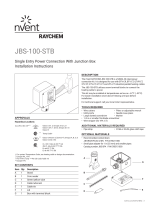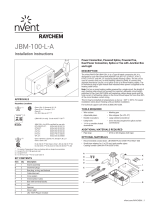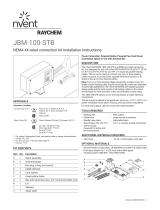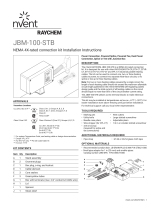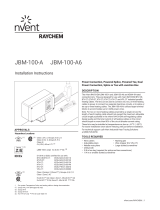
nVent.com
nVent
DESCRIPTION
The nVent RAYCHEM JBS-100-A and nVent RAYCHEM JBS-100-A6
are NEMA 4X-rated power connection kit. It is designed for use with
nVent RAYCHEM BTV-CR, BTV-CT, QTVR-CT, XTV-CT, KTV-CT and
VPL-CT industrial parallelheating cables.
The JBS-100-A6 utilizes larger terminal blocks to accommodate
up to 6 AWG power wires.
This kit may be installed at temperatures as low as –40°F (–40°C).
For easier installation store above freezing untiljust before
installation.
For technical support call nVent at (800)545-6258.
TOOLS REQUIRED
• Wire cutters • Adjustable pliers
• Utility knife • Needle nose pliers
• Large slotted screwdriver • Marker
• Wire stripper (for VPL-CT)
• 1/4 in or smaller flat-blade screwdriver
ADDITIONAL MATERIALS REQUIRED
• Pipe strap • GT-66 or GS-54 glass cloth tape
OPTIONAL MATERIALS
• Recommended conduit drain:
JB-DRAIN-PLUG-3/4INP/N 278621-000
• Small pipe adapter for 1 in (25 mm) and smaller pipes:
Catalog number JBS-SPA P/N E90515-000
KIT CONTENTS
Item Qty Description
A 1 Stand assembly
B 1 Core sealer
C 1 Green/yellow tube
D 1 Cable lubricant
E 1 Cable tie
F 1 Lid
G 1 Box with terminal blocks
APPROVALS
CLI, ZN1, AEx e II T*
(1)
Ex e II T*
Hazardous Locations
(1)
Except VPL
* For system Temperature Code, see heating cable or design documentation
.
(2)
Except KTV-CT
Class I, Div. 2, Groups A, B, C, D
Class II, Div. 2, Groups E, F, G
Class III
JBS-100-A is IECEx certified for use with:
BTV-CR/BTV-CT: IECEx BAS 06.0043X
QTVR-CT: IECEx BAS 06.0045X
XTV-CT: IECEx BAS 06.0044X
KTV-CT: IECEx BAS 06.0046X
VPL-CT: IECEx BAS 06.0048X
– WS
(JBS-100-A only*) Ex e IIC T* Gb
(2)
IECEx
A
D
G
F
E
B
C
JBS-100-A, A6
Single Entry Power Connection with Junction Box
Installation Instructions

2 | nVent.com
24 in
(60 cm)
12 in
(30 cm)
45°
Indentation (bus wire
connection on VPL
heating cables only).
1
18 in
(45 cm)
Label on stand
indicates
direction of
box opening.
Drain
hole
2
• Allow approximately 24 in (60 cm)
of heating cable for installation. For
VPL, cut cable 12 in (30 cm) from
bus indentation.
• Cut off heating cable end at about
45° for easier insertion.
• Optional: If stand is to be
installed on bottom side of pipe,
knock out drain hole prior to
inserting cable.
• With label on stand facing
desired direction of box
opening, push 18 in (45 cm) of
heating cable through stand.
Use cable lubricant if needed.
• Square off cable
end with 90° cut.
• Do not attach
stand to pipe
until step 12.
Clear jacket
Inner jacket
Braid
Outer
jacket
Heating element
Insulated bus wire
Bus wire connection
VPL-CT
Inner jacket
Outer jacket
Spacer
Conductive fiber
Bus wire
Braid
XTV-CT, KTV-CT
Bus wire
Conductive core
Inner jacket
Braid
Outer
jacket
BTV-CR, BTV-CT, QTVR-CT
Heating cable types
This component is an electrical device that
must be installed correctly to ensure proper
operation and to prevent shock or fire. Read these
important warnings and carefully follow all of the
installation instructions.
• To minimize the danger of fire from sustained
electrical arcing if the heating cable is
damaged or improperly installed, and to
comply with the requirements of nVent,
agency certifications, and national electrical
codes, ground-fault equipment protection
must be used. Arcing may not be stopped by
conventional circuit breakers.
• Component approvals and performance are
based on the use of nVent-specified parts only.
Do not use substitute parts or vinyl electrical
tape.
• The black heating cable core and fibers are
conductive and can short. They must be
properly insulated and kept dry.
• Damaged bus wires can overheat or short. Do
not break bus wire strands when scoring the
jacket or core.
• Keep components and heating cable ends dry
before and during installation.
• Use only fire-resistant insulation materials, such
as fiberglass wrap and flame-retardant foam.
HEALTH HAZARD: Prolonged or repeated contact
with the sealant in the core sealer may cause skin
irritation. Wash hands thoroughly. Overheating or
burning the sealant will produce fumes that may
cause polymer fume fever. Avoid contamination
of cigarettes or tobacco. Consult MSDS VEN 0058
for further information.
CHEMTREC 24-hour emergency telephone:
(800) 424-9300
Non-emergency health and safety information:
(800) 545-6258
.
WARNING:
CAUTION:

nVent.com | 3
1/4 in
(5 mm)
6 1/2 in
(165 mm)
BTV and QTVR
7 1/2 in
(190 mm)
Do not cut braid.
XTV and KTV
BTV and QTVR
VPL
Go to Step 5B
Go to Step 5A
Go to Step 5C
5A3
4
• Lightly score outer jacket around and down
as shown.
• Bend heating cable to break jacket at score,
then peel off jacket.
• Push braid back to
create a pucker.
• At pucker use a
screwdriver to
open braid.
• Bend heating cable and
work it through opening
in braid.
• Lightly score inner
jacket around and
down as shown.
• Peel off inner
jacket.
• Notch core.
• Peel bus wire from
core.
• Score core
between buswires
at inner jacket.
• Bend and snap core.
• Peel core from bus wire.
• Remove any remaining
core material from bus
wires.
• Pull braid tight to make
pigtail.
Go to Step 6

4 | nVent.com
1/2 in
(13 mm)
6 in
(152 mm)
6 in
(152 mm)
VPL
5C
• Push braid back
and bunch as tight
as possible.
• Lightly score inner
jacket around and
down as shown.
• Peel off inner jacket.
• Unwind heating
element, cut and
remove as shown.
• Lightly score
clear jacket
around and
down as
shown.
• Bend heating cable
to break jacket at the
score then peel off
jacket.
• Push braid
forward. Use a
screwdriver to
open braid as
shown.
• Bend heating cable
and work it through
opening in braid.
• Remove
insulation from
ends of bus
wires.
• Pull braid tight
to make pigtail.
Go to Step 6
6 1/2 in
(165 mm)
XTV and KTV
5B
• Push braid back to
create a pucker.
• At pucker use a
screwdriver to
open braid.
• Bend heating cable and
work it through opening
in braid.
• Lightly score inner
jacket around and
down as shown.
• Peel off inner jacket.
• Cut and remove all
fiber strands.
• Score and remove
center spacer.
• Remove any
remaining fiber
material from bus
wires.
• Pull braid tight to
make pigtail.
Go to Step 6

nVent.com | 5
5/8 in
(15 mm)
Make sure the bus
wires do not kink,
bunch, or crossover.
1/2 in
(13 mm)
1/2 in
(13 mm)
1 in (25 mm)
6
8
10 11
Tubes
Make sure all strands
go into the tubes.
7
9
• Mark the jacket
as shown.
• Push core sealer onto the heating cable to the mark made
in step 6.
Note: Extra force may be required for larger cables or at
lower temperatures.
• Slip the green/yellow tube onto the braid.
Heat-shrinking is not required.
• Trim bus wires and braid.
• If needed, re-twist and straighten bus wires,
then insert into the guide tubes as shown.
• Remove the guide tubes and
dispose of them in a plastic
bag.
• Pull heating cable back into stand so 1 in (25 mm) is
exposed as shown. Use cable lubricant if needed.
CAUTION: Health Hazard.
Wash hands after contact with sealant. Consult
material safety data sheet VEN 0058.

6 | nVent.com
1 in (25 mm)
Glass cloth tape
Pipe strap
JBS-SPA
adapter for
small pipes
Note: For 1 in (25 mm)
and smaller pipes use
adapter (purchased
separately) and install
between stand and pipe.
Position
adapter
this side
up.
Trim
12
13
15
Notch
14
• Fasten stand to pipe with label
facing desired direction of box
opening. Do not pinch heating
cable.
• Loop and tape extra heating
cable to pipe.
• Screw box onto stand until it stops. Do not overtighten.
• Insert cable tie through slots on stand and box, and
tighten firmly to prevent box rotation.
• Loosen locknut using adjustable pliers.
• Lift box and rotate. Make sure tab on threaded piece fits
into one of the four notches in box.
• Tighten locknut.
(Optional) To change direction of box opening:

nVent.com | 7
1
2
Screwdriver slot
Wire hole
Wire
16
This kit uses spring clamp style terminals.
Terminals use a steel spring to clamp the wire to provide
improved vibration resistance, reduced maintenance and
faster installation.
To connect wires, firmly insert a slotted screwdriver into
the square hole (
1
2
) to open the spring. When fully inserted,
the screwdriver will lock into place, allowing you to remove
your hand and insert the wire into the round hole (
1
2
).
Remove the screwdriver to clamp the wire. The wire is held
securely against the bus bar for low contact resistance
over time without the need to periodically retighten screws.
• Push screwdriver FIRMLY
into square hole.
• Insert wire into round hole.
• Use green terminal for
braid and ground wire.
• Remove screwdriver.
• Repeat for all connections.

nVent recommends
the use of a conduit drain
to prevent water
condensation build-up.
Make sure
conductors are
not exposed.
Conduit
drain
3/4 in locknut
Water tight
conduit seal
1/2 in
(13 mm)
Power and ground wires
Weather seal
–WS
nVent.com
nVent
17
18
• Install conduit and fittings as shown.
To minimize loosening due to pipe
vibration, use flexible conduit.
• Pull in power and ground wires, strip
off 1/2 in (13 mm) of insulation and
terminate.
• Install lid.
• Apply insulation and cladding.
• Weather-seal the stand entry.
• Leave these instructions with the end
user for future reference.
©2018 nVent. All nVent marks and logos are owned or licensed by nVent Services GmbH or its aliates. All other trademarks are the property of their respective owners.
nVent reserves the right to change specications without notice.
Raychem-IM-H56046-JBS100A100A6-EN-1805 PN 789781-000
nVent.com
North America
Tel: +1.800.545.6258
Fax: +1.800.527.5703
Europe, Middle East, Africa
Tel: +32.16.213.511
Fax: +32.16.213.604
Asia Pacific
Tel: +86.21.2412.1688
Fax: +86.21.5426.3167
Latin America
Tel: +1.713.868.4800
Fax: +1.713.868.2333
/
